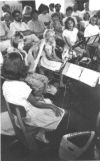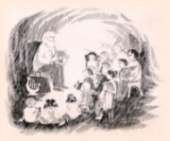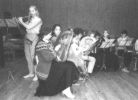|
The Lyre in Education
From observations and suggestions by a teacher

Aufbauend auf den spiele-
rischen Umgang mit dem
Instrument, ist das ge-
meinsame konzertante
Musizieren auch schon
für die "Kleinen" ein
großes Erlebnis. |

Starting school and music ,,.... I
wish to indicate
from my teaching experience
what rhythmic-musical instruc-
tions offer to the learning
process. In a lesson all
aspects of a child's being need
to be addressed and engaged,
singing and musicmaking
express feeling, and so both
have a place in the daily
lesson. They deepen and more
firmly establish the im-
pressions which have been
conveyed earlier in the lesson.
The music teacher may indeed
have a full range of in-
struments at his disposal,
but the classteacher working
with musical interludes |
in
the
normal course of the
day achieves at
least as good
an effect and
may even work
therapeutically by daily
repetition.
Magical music -
a first teaching project My first music
project
starts by telling the
story of the goblin
with the net from
the childrens book
,,Liputto" by Jacob Streit
(Urachhaus 1988).
A goblin who lives in
a cave dose to a
pond asks a spider
to weave him a
net and then
looks out for what
he may catch.
First he catches a
small Goldfish which he
keeps in a jar in
his cave, luckily
a raven can free
the poor fish.
The next victim is a
butterfly and after
that he catches a
frog with a lasso
made with hair from
his beard.
In my version of the
story granny Morla lives
dose to the pond
and has watched all
this mischief and
resolves to get the
goblin to change his
wicked ways. With a sack
on her back she
creeps round the
pond and hides behind
a bush, out of her
sack she takes
her magic instrument
and begins to play
- here I take the
Lyre out of its
cover and start to
sing and play. The gentle
sound of the instrument
is almost magical. |
Comments
made
at the end of the
week indicated that the
sound of the Lyre
had made a
lasting impression:
an overactive child
says it liked the magic
music best, another child
who finds it difficult
to concentrate brings
a picture he has drawn
in which the Lyre
has pride of place.
Children blossom in
experiences and in this
context experiences are
things which children
can feel, get to
know and can.talk about.
One must hope
that more teacher
s will find the courage
to sing and play,
making music in ordinary
class lessons so
that a far greater range
and variety of sounds,
moods, vibrations and
movements flow into
the formative educational
processes with children
than is usually envisaged
or prescribed."
(Extract from a teaching
unit by Astrid Fries,
a teacher for lower schools,
available from
Bochinsky Publishers,
Frankfurt a..M. or
Gärtner Lyre Workshop) |

Whether in
California, Sao Paub
or Milan or as here
in Berlin, joy of music
making radiates from
playing the Lyre. |
|
|
|
|
|
|
An experience
in the classroom
with the large Kantele ,,One of those
sultry
days before full moon, the
children came back from break
wild, noisy and quarrelsome.
Making matters worse the
teachers had still concluded
a discussion before coming
late, after the children to their
classrooms. The noisy goings-
on in there could already be
heard some way off. How to
settle these boisterous chil-
dren ? With a few unmistak-
able gestures I
directed them to
return to their desks, one child
still sat under my desk while
I gently removed the Käntele
from its case, sat on a chair
and began to play. Straightway
peace and harmony and a
more reflective mood seemed
to establish itself , even the girl
hiding under my desk, feared
and known for hitting other
children, returned quietly to
her own place. This order and
inner peace lasted almost half
an hour, while the children
drew pictures with their
crayons of a king who in the
still hours of the evening
wandered over the mysterious
bridge, playing and singing to
his Kantele, while the dragon
slept below it |
............
Whenever I
myself battle with
lack of inner
equilibrium, this
instrument helps me
to regain inner
harmony. Bach Inventions
can be played on it
quite weil. For contemporary man,
so often under stress,
this instrument has
a definite therapeutic effect,
bringing harmony to heart and circulation,
calming us down
(Extract from a text by
Thomas Koller, teacher, Winterthur,
Switzerland)
The value of
theLyre in
Antroposophical
work ,,Wherever one visits a
Rudolf Steiner Waldorf School,
whether in Sao Paulo or Milan,
California or New Zealand
one will meet the Gärtner Lyres
and the enlivening effect
which seems to originate from
these instruments.
lt proves to be an
equally suitable instrument
in the education of
young as well as older
children, making a formative
contribution to festivals
or concerts whether of a
serious or joyful nature.
lt is also suitable for the treatment
of mentally handicapped
or ill children
and adults.
Rudolf Steiner has
given us the
important indication
that for the child from
Kindergarten up to nine years,
that is the beginning of class Three,
we should not yet use the major
or minor scales, but emphasise
the mood of fifths which
lives in the pentatonic tone sequence
of d-e-g-a-b-d-e and so on.
To this end Lothar Gärtner developed
the ten-stringed Kantele or Wingkantele
which can be tuned to that scale.
(In subsequent years,
exchanging only three strings,
this instrument can be re-tuned
to a ten-tone major scale) |
To
encourage the children to
tuneful playing and more
important still to encourage
them to listen to it,
I begin music lessons
often by saying: ,
The instrument you hold
in your hands is called
Wingkantele.
And do you know why ?
Because not only
does it look like a
wing but the tones
you play on it
will have wings and can fly
far away.'
The special charm of this
pentatonic instrument is
that it can never sound
wrong because
the five tone sequence
has no semi-tones wich
can produce disharmony.
One can play arpeggio-style
by running ones fingers
over the strings
and they will always
produce harmony."
(Extract from a text
by Helmut v. Wartburg,
at the occasion of the
fiftieth anniversa
of the Gärtner Lyre Workshop)
(Extract from a text
by Helmut v. Wartburg,
at the occasion of the
fiftieth anniversa
of the Gärtner Lyre
Workshop) |
|
|
|
|

back
|
|